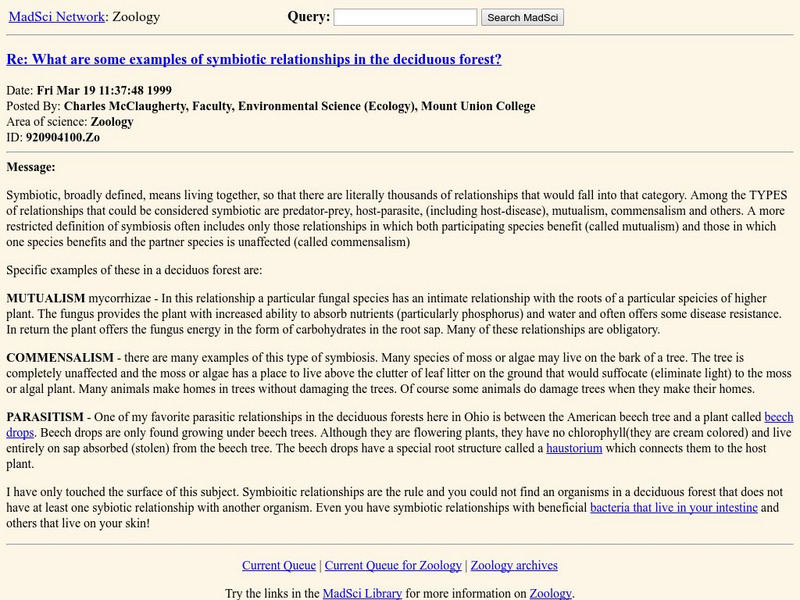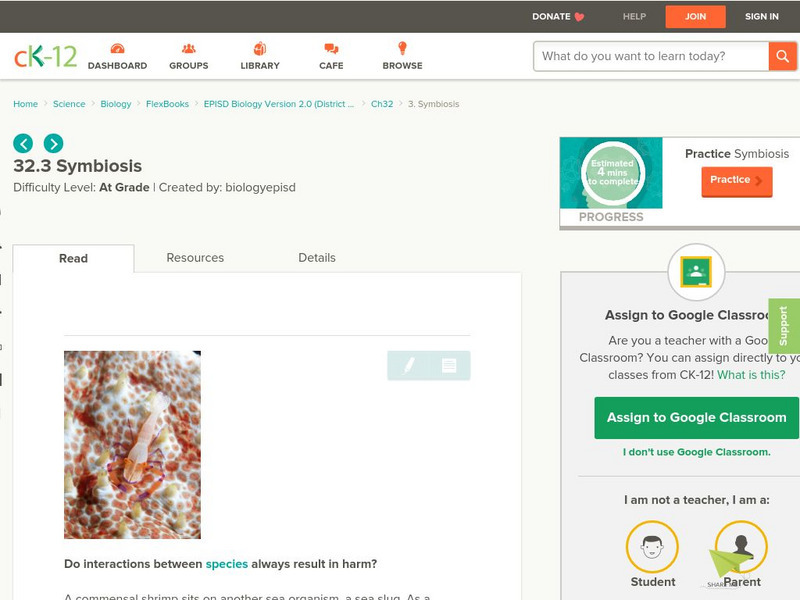Curated OER
Coral Bleaching
Students examine the relationship between corals and zooxanthellae, identify stresses to corals, and explain coral bleaching. In this sea life lesson students predict the effects of increased temperatures on coral reefs.
Curated OER
Climate
Students study zoanthids. In this science and art lesson, students use line to create texture and how to use colors to create value. Students share their beautiful mat zoanthids with the rest of the class.
Curated OER
Plant Structure
In this plant science worksheet, learners complete a crossword puzzle with 48 questions. They identify the different parts of a plant.
Curated OER
Blue Planet: Coral Seas
Students create a poster about coral reefs. In this oceanography lesson, students teach the class about a given aspect of the coral reefs. Students create posters with images and facts about this habitat.
Curated OER
Diversity of Life
Students study fungi and its characteristics. In this fungi lesson students collect and observe fungi then answer questions on what they saw.
Curated OER
One Tough Worm
Students explain the process of chemosynthesis. They are able to explain the relevance of chemosynthesis to biological communities in the vicinity of cold seeps.
Curated OER
C.S.I. on the Deep Reef
Pupils study chemotropic sybioses and chemotropic nutrition. In groups, they complete a Chemotrophic Species Investigations (CSI) Worksheet.
Curated OER
When Electricity Came to Arkansas
Young scholars examine the role that Harvey Couch played in developing a competitive market system in Arkansas. They discuss key vocabulary terms, conduct research and interviews, and write a brief summary of Harvey Couch's life and...
Curated OER
Earth's Recyclers
Middle schoolers work together in groups to report on different topics related to decomposition. They answer questions and share their answers with the class. They discuss any topic that is unclear.
Curated OER
Egg Carton Coral
Students use egg cartons to construct models of coral colonies showing
many aspects of the coral's natural history - including the structure of
coral polyps and the coral colony's colonial life style.
Curated OER
Can Fun Gus Help Plants/Trees Grow?
Students participate in an experiment in which they test the growth of different types of plants. They discover how growth rates vary using inoculum. They draw pictures and are read books about plants to end the lesson.
Curated OER
SEXUAL LIFE CYCLE DEVELOPMENT USING MONOCYSTIS
Students perform a lab to becoe familar with scientific concepts. The skill of inquiry is essential and this lesson furthers its development. The intelligence of kinesthetics is used as learners perform the many aspects of this lab...
Curated OER
Exploring Ecology
Students explore the basics of ecology through numerous hands-on and relevant activities. They participate in an online food chain demonstration, which explores food web dynamics. They dissect owl pellets, examine the prey's bones, and...
National Geographic
National Geographic: Symbiotic Relationships in Marine Ecosystems
In this lesson students analyze videos to make observations about species, populations, and communities of organisms and discuss their symbiotic relationships. Then they create a hypothetical marine ecosystem and describe the adaptive,...
CK-12 Foundation
Ck 12: Life Science: Symbiotic Relationships of Fungi
[Free Registration/Login may be required to access all resource tools.] Fungi don't live in isolation. They often interact with other species. In fact, fungi can be dependent on another organism for survival. When two species live close...
Science Struck
Science Struck: Symbiotic Relationships in the Deciduous Forest
Explains what a symbiotic relationship is, the five main types of symbiosis, and provides examples of symbiotic relationships among living things in a deciduous forest.
MadSci Network
Symbiotic Relationships in the Deciduous Forest
A brief definition of symbiotic, followed by explanations of mutualism, commensalism, and parasitism.
Sophia Learning
Sophia: Symbiotic Relationships: Lesson 2
This lesson will introduce the three types of symbiotic relationships and give examples of each. It is 2 of 4 in the series titled "Symbiotic Relationships."
Sophia Learning
Sophia: Symbiotic Relationships: Lesson 4
This lesson will introduce the three types of symbiotic relationships and give examples of each. It is 4 of 4 in the series titled "Symbiotic Relationships."
Science Struck
Science Struck: Symbiotic Relationships in the Desert
Describes three types of symbiotic relationships that can be found in a desert biome.
NC State University
North Carolina State University: Symbiotic Relationships
Includes a description of symbiosis in general, then lists and defines types of symbiosis including mutualism, commensalism, parasitism, competition, and neutralism. Includes a chart which summarizes the different types of relationships....
CK-12 Foundation
Ck 12: Biology: Symbiotic Relationships of Fungi
[Free Registration/Login may be required to access all resource tools.] Discusses parasitic and mutualistic relationships of fungi.
Science Education Resource Center at Carleton College
Serc: It Takes Teamwork: How Endosymbiosis Changed Life on Earth
A tutorial on symbiotic relationships that explores the differences between prokaryotic and eukaryotic cells as well as the origins of eukaryotic organelles possibly being from endosymbiotic relationship. This tutorial also offers...
CK-12 Foundation
Ck 12: Episd: Symbiosis
[Free Registration/Login may be required to access all resource tools.] Identify and understand the various types of symbiotic relationships. Recognize the three primary kinds of symbiosis.
Other popular searches
- Symbiotic Relationships
- 5 Symbiotic Relationship
- Good Buddies Symbiotic
- Good Buddy Symbiotic
- Symbiotic Relations
- Symbiotic Interactions
- Symbiotic Relationshios
- Relationships Symbiotic Dog





















